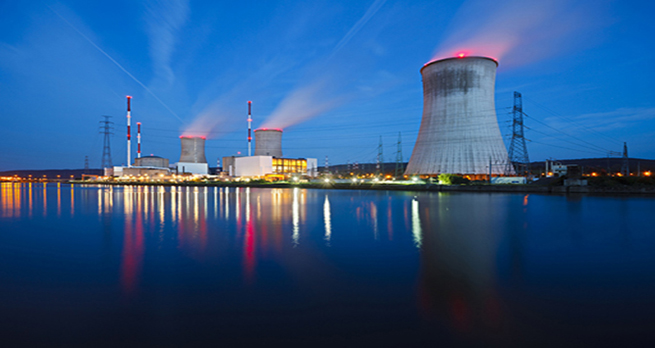1.2 Radioactive atoms
What does it mean for an atom to be radioactive? What forces are at play within the nucleus?
Forces within the nucleus
Consider a nucleus of carbon-12 shown in Figure 4. It contains six positive protons and six neutral neutrons, crammed into an extremely small volume.
You may already know that like charges repel, this is an aspect of the electromagnetic force. Therefore, you would imagine that the positively charged protons would mutually repel each other and the nucleus would fly apart! The fact that nuclei hold together suggests the presence of another force within the nucleus that pulls the nucleons together. The force in question is the strong force. It is beyond the scope of this course to give a full explanation of the strong force, but the key idea for us is that it pulls nucleons together within the nucleus.
So, to summarise:
- There is a repulsive electromagnetic force within the nucleus that acts between protons.
- There is an attractive strong force within the nucleus that acts between both protons and neutrons.
Neutrons are necessary to hold the nucleus together. In Table 5, notice that as nuclei get bigger the ratio of neutrons to protons increases – the uranium nucleus needs significantly more neutrons than protons to hold together.
| Element | Isotope | Number of protons | Number of neutrons |
|---|---|---|---|
| carbon | 6 | 6 | |
| calcium | 20 | 20 | |
| zinc | 30 | 35 | |
| iodine | 53 | 74 | |
| uranium | 92 | 146 |
Stability and instability
We can now visualise the nucleus as an energetic and dynamic environment; densely packed with two opposing forces acting on the particles within it.
Within many nuclei, the two forces reach an equilibrium. Such nuclei are able to hold together and are said to be stable. In other nuclei the interaction between the forces can make the nuclei unstable. To gain stability, the unstable nucleus will emit particles and energy, and such nuclei are called radioactive. When it emits a particle, the nucleus is said to decay.
Most elements within the periodic table have both stable and radioactive isotopes. For example, carbon-12 is stable while carbon-14 is radioactive. The stable form of each element tends to be the form that is most abundant. It is possible to quantify how radioactive an isotope is by how many particles are emitted in a given time – you will examine this later in the course when you’ll consider half-life.
The emitted particles have enough energy to detach electrons from atoms or molecules that they interact with. This turns the neutral atoms or molecules into charged ions and hence the emitted particles are sometimes called ionising radiation.
Radioactivity and nuclear energy are not the same thing but they are linked – if it were possible to somehow get the energy without having to worry about the radioactivity, nuclear energy would be a lot less problematic! But the radioactive particles that are emitted mean that there are all sorts of problems associated with generating nuclear energy.
Radioactivity isn’t new – it has been around longer than humans and has always been part of the environment. In fact, it is radioactive decay that provides the majority of the Earth’s internal heat that causes volcanoes to erupt and drives plate tectonics. Radioactive materials are all around you!
Watch the video in the next section for some background to the discovery of radioactivity.

